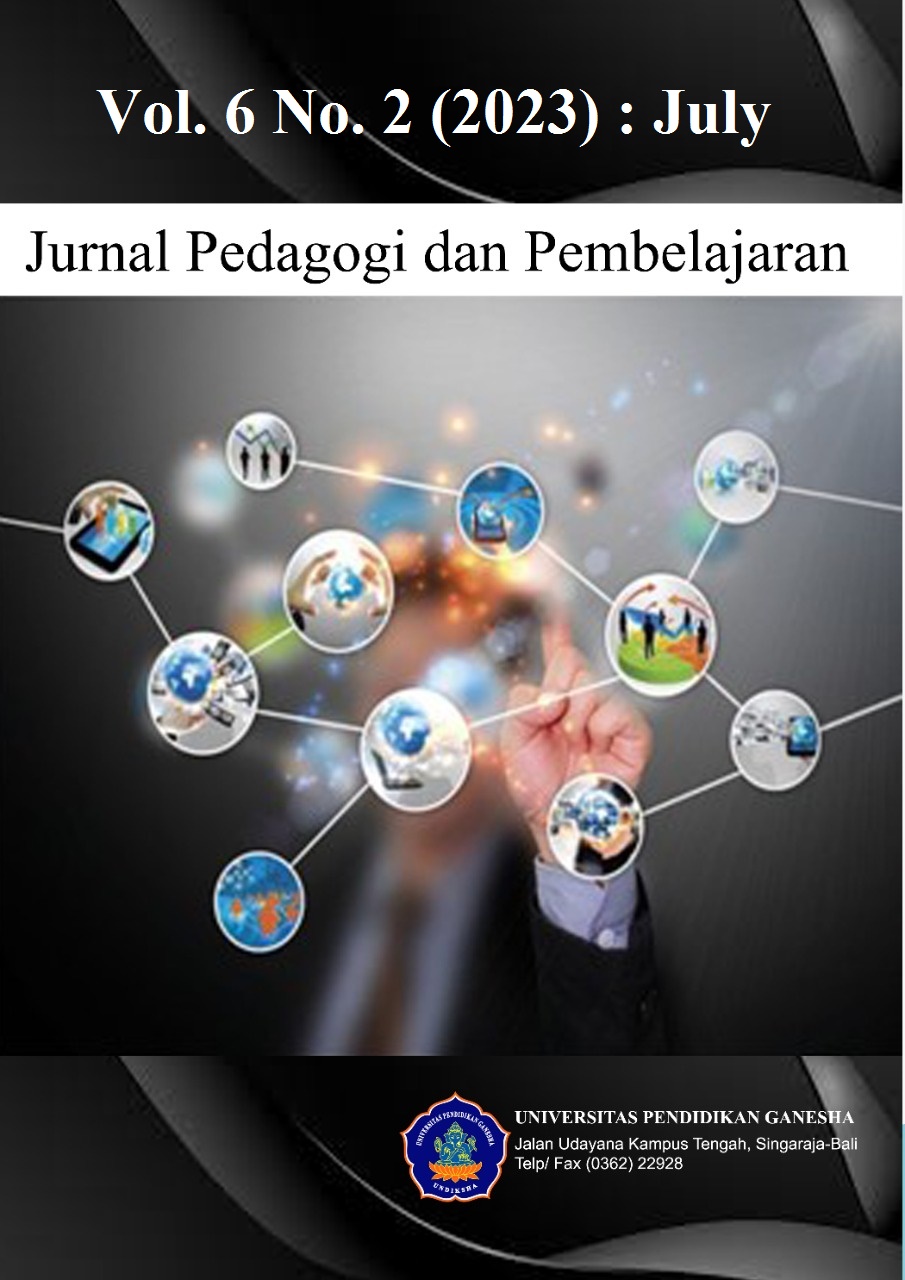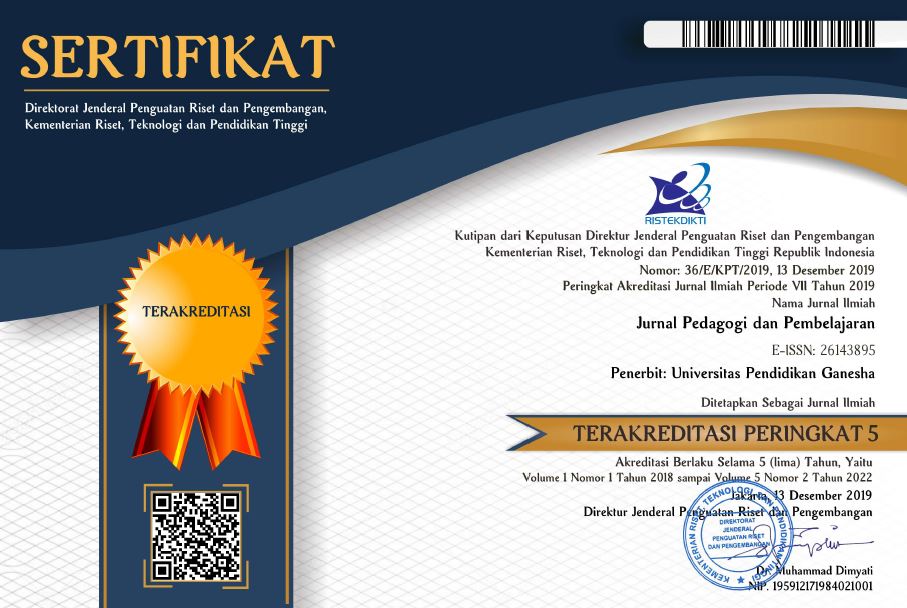Monopoly Edutainment Media and its Implementation Through the Course Review Horay Model in Learning to Write Indonesian
DOI:
https://doi.org/10.23887/jp2.v6i2.64441Keywords:
Monopoly Media, Edutainment, Model Course Review Horay, WritingAbstract
The low ability of students to write is due to teachers' need for more use of learning media during the learning process. So to overcome these problems, we need media to help the student learning process. This research aims to develop edutainment monopoly media and its implementation through the course review horay model. This research belongs to the type of development research which was developed using the ADDIE model. The ADDIE model comprises five research stages: analysis, design, development, implementation, and evaluation. The subjects of this study were two learning material experts and two learning media experts. The test subjects included two teachers, three individual students, and six small group test students. Methods of data collection using test and nontest methods. The data collection instrument used questionnaires and test questions. The techniques used in collecting data are descriptive quantitative analysis, qualitative, and inferential statistics. The study's results, namely assessments from content and learning media experts, obtained very good qualifications. The test results for the two teacher responses scored 91.7% (very good). The results of student responses were 91.94% (very good). The practicality test results scored 99.7% (very practical). The individual trial results were 93.6 (very good). The results of the small group trials were 91% (very good). The t-test results showed significant differences before and after using edutainment monopoly media and its implementation through the course review horay model. Based on these results, monopoly edutainment media and its implementation through the course review horay model can improve students' writing skills.
References
Amelia, D. P., & Harahap, A. (2021). Application of Interactive Multimedia-Based Mathematics Learning Media to Increase Students’ Interest in Learning. Budapest International Research and Critics Institute (BIRCI-Journal): Humanities and Social Sciences, 4(2), 3153–3161. https://doi.org/10.33258/birci.v4i2.2040. DOI: https://doi.org/10.33258/birci.v4i2.2040
Angga, P. M. W., Sudarma, I. K., & Suartama, I. K. (2020). E-Komik Pendidikan Untuk Membentuk Karakter Dan Meningkatkan Hasil Belajar Siswa Kelas V Pada Mata Pelajaran Bahasa Indonesia. Jurnal Edutech Undiksha, 8(2), 93. https://doi.org/10.23887/jeu.v8i2.28920. DOI: https://doi.org/10.23887/jeu.v8i2.28920
Antari, N. L. G. S., Pudjawan, K., & Wibawa, I. M. C. (2019). Pengaruh Model Pembelajaran Kooperatif Tipe Course Review Horay Berbantuan Media Gambar Terhadap Hasil Belajar IPA. International Journal of Elementary Education, 3(2), 116. https://doi.org/10.23887/ijee.v3i2.18512. DOI: https://doi.org/10.23887/ijee.v3i2.18512
Arif, M. F., Praherdhiono, H., & Adi, E. P. (2019). Pengembangan Video Pembelajaran Ipa Materi Gaya Untuk Siswa Sekolah Dasar. Jurnal Kajian Teknologi Pendidikan, 2(4), 329–335. https://doi.org/10.17977/um038v2i42019p329.
Astuti, N. M. M. A., Ardana, I. K., & Putra, M. (2019). Pengaruh Model Pembelajaran Course Review Horay Berbantuan Media Question Card Terhadap Kompetensi Pengetahuan IPA. Journal for Lesson and Learning Studies, 2(3). https://doi.org/10.23887/jlls.v2i3.19506. DOI: https://doi.org/10.23887/jlls.v2i3.19506
Astutik, I., Pratama, L. D., & Lestari, W. (2020). Efektifitas Penggunaan Media Edutainment Di Tengah Pandemi Covid-19. Aksioma: Jurnal Program Studi Pendidikan Matematika, 9(2), 413–423. https://doi.org/10.24127/ajpm.v9i2.2783. DOI: https://doi.org/10.24127/ajpm.v9i2.2783
Cholifah, T. N., & Saputro, G. I. (2022). Pengembangan Media Pembelajaran Vidam (Video Animasi) Pembelajaran Tematik Untuk Meningkatkan Minat Belajar Siswa Kelas 3 SD. Primary Education Journals (Jurnal Ke-SD-An), 2(2), 120–130. https://doi.org/10.33379/primed.v2i2.1613. DOI: https://doi.org/10.33379/primed.v2i2.1613
Darmayanti, N. K. D., & Abadi, I. (2021). Pengembangan Media Pembelajaran Daring Komik Virtual dalam Muatan Materi Gagasan Pokok dan Gagasan Pendukung Bahasa Indonesia. Mimbar PGSD Undiksha, 9(1), 170–179. https://doi.org/10.23887/jjpgsd.v9i1.32481. DOI: https://doi.org/10.23887/jjpgsd.v9i1.32481
Daryanti, E. W., Laila, A., & Saidah, K. (2022). Pengembangan Media Karikatur Berbasis Kearifan Lokal Kediri bagi Siswa Sekolah Dasar. Efektor, 9(1), 11–22. https://doi.org/10.29407/e.v9i1.16433. DOI: https://doi.org/10.29407/e.v9i1.16433
Firdaus, H., Laensadi, A. M., Matvayodha, G., Siagian, F. N., & Hasanah, I. A. (2022). Analisis Evaluasi Program Kurikulum 2013 Dan Kurikulum Merdeka. Jurnal Pendidikan Dan Konseling, 4(4). https://doi.org/10.31004/jpdk.v4i4.5302.
Friantary, H., & Martina, F. (2018). Evaluasi Implementasi Penilaian Hasil Belajar Berdasarkan Kurikulum 2013 oleh Guru Bahasa Inggris dan Bahasa Indonesia di MTS Ja-Alhaq Kota Bengkulu. Jurnal Penelitian Pendidikan Bahasa Indonesia, Daerah, Dan Asing, 1(2), 76–95. https://doi.org/10.31540/silamparibisa.v1i2.202. DOI: https://doi.org/10.31540/silamparibisa.v1i2.202
Fuchsova, M., & Korenova, L. (2019). Visualization in basic science and engineering education of future primary school teachers in human biology education using augmented reality. European Journal of Contemporary Education, 8(1), 92–102. https://doi.org/10.13187/ejced.2019.1.92. DOI: https://doi.org/10.13187/ejced.2019.1.92
Halimah, W., Octafianus, P., Jamahsari, F. N., & Dasmo, D. (2021). Pengembangan Media Pembelajaran E-Mind Mapping Berbasis Flipbook pada Mata Pelajaran Fisika SMA Kelas 11. Schrodinger Jurnal Ilmiah Mahasiswa Pendidikan Fisika, 2(2), 100–107. https://doi.org/10.30998/sch.v2i2.4360. DOI: https://doi.org/10.30998/sch.v2i2.4360
Hermawan, Putro, K. H., & Sugini. (2018). The Effectiveness of Course Review Horay Method on Social Sciences Learning Achievement of Visually Impaired Students. Journal of Icsar, 2(2). https://doi.org/10.17977/um005v2i22018p153. DOI: https://doi.org/10.17977/um005v2i22018p153
Ismawanti, A., Unaenah, E., Putri, D. C., & Azzahra, F. D. (2022). Analisis Penggunaan Media Pembelajaran Papan Pecahan Kelas Tinggi Di Sd Negeri Periuk Jaya Permai Tangerang. Arzusin : Jurnal Manajemen Dan Pendidikan Dasar, 2(4). https://doi.org/10.36088/arzusin.v2i4.453. DOI: https://doi.org/10.58578/arzusin.v2i4.453
Jultia, W. O., Sahlan, & Hanafi, F. (2019). Kemampuan menulis teks eksposisi siswa kelas VIII SMP Negeri 1 Duruka. Jurnal Bastra (Bahasa Dan Sastra), 4(3). https://doi.org/10.36709/jb.v4i3.10754. DOI: https://doi.org/10.36709/jb.v4i3.10754
Krissandi, A. D. S. (2018). Pengembangan video tematik sebagai pengantar pembelajaran kurikulum 2013 di sekolah dasar. Premiere Educandum : Jurnal Pendidikan Dasar Dan Pembelajaran, 8(1), 68. https://doi.org/10.25273/pe.v8i1.2233. DOI: https://doi.org/10.25273/pe.v8i1.2233
Kurniawan, D., Kuswandi, D., & Husna, A. (2018). Pengembangan Media Video Pembelajaran Pada Mata Pelajaran Ipa Tentang Sifat Dan Perubahan Wujud Benda Kelas Iv Sdn Merjosari 5 Malang. JINOTEP (Jurnal Inovasi Dan Teknologi Pembelajaran) Kajian Dan Riset Dalam Teknologi Pembelajaran, 4(2), 119–125. https://doi.org/10.17977/um031v4i22018p119. DOI: https://doi.org/10.17977/um031v4i22018p119
Maqfiroh, D. N. M., Khutobah, K., & Budyawati, L. P. I. (2020). Pengembangan Media Motif (Monopoli Edukatif) Dalam Pembelajaran Berbasis Multiple Intelligence Pada Anak TK Kelompok B. Cakrawala Dini: Jurnal Pendidikan Anak Usia Dini, 11(1), 65–74. https://doi.org/10.17509/cd.v11i1.24230. DOI: https://doi.org/10.17509/cd.v11i1.24230
Meganingtyas, B. R., Winarni, R., & Murwaningsih, T. (2019). The Effect of Using Course Review Horay and Talking Stick Learning Methods Towards Social Science Learning Result Reviewed From Learning Interest. International Journal of Educational Research Review, 190–197. https://doi.org/10.24331/ijere.518053. DOI: https://doi.org/10.24331/ijere.518053
Mudarris, B., Rizi, F., & Islamiyah, N. (2022). Penggunaan Media Vlog dalam Pengembangan Kemampuan Motorik Anak Badrul. Jurnal Ilmiah Potensia, 7(1), 1–10. https://doi.org/10.33369/jip.7.1.%25p.
Munandar, H., Sutrio, S., & Taufik, M. (2018). Pengaruh Model Pembelajaran Berbasis Masalah Berbantuan Media Animasi Terhadap Kemampuan Berpikir Kritis dan Hasil Belajar Fisika Siswa SMAN 5 Mataram Tahun Ajaran 2016/2017. Jurnal Pendidikan Fisika Dan Teknologi, 4(1), 111–120. https://doi.org/10.29303/jpft.v4i1.526. DOI: https://doi.org/10.29303/jpft.v4i1.526
Mustikaningrum, G., Pramusinta, L., Ayu, S., & Umar, M. (2020). Implementasi Pendidikan Karakter Terintegrasi Kurikulum Dan Metode Pembelajaran Pada Masa Pandemi Covid-19. Auladuna: Jurnal Pendidikan Dasar Islam, 7(2), 154–164. https://doi.org/10.24252/auladuna.v7i2a5.2020. DOI: https://doi.org/10.24252/10.24252/auladuna.v7i2a5.2020
Naharir, R. A., Dantes, N., & Kusmariyatni, N. (2019). Pengaruh Model Pembelajaran Course Review Horay Berbantuan Media Video Pembelajaran Terhadap Hasil Belajar Matematika Siswa Kelas V Semester II SD Gugus VI Kecamatan Sukasada. MIimbar PGSD Undiksha, 7(1). https://doi.org/10.23887/jjpgsd.v7i1.16975.
Natalya, L., & Purwanto, C. (2018). Exploratory and Confirmatory Factor Analysis of the Academic Motivation Scale (AMS)–Bahasa Indonesia. Makara Human Behavior Studies in Asia, 22(1), 29. https://doi.org/10.7454/hubs.asia.2130118. DOI: https://doi.org/10.7454/hubs.asia.2130118
Nurwahidah, Maryati, S., Nurlaela, W., & Cahyana. (2021). Permainan Tradisional Sebagai Sarana Mengembangkan Kemampuan Fisik Motorik Anak Usia Dini. PAUD Lectura: Jurnal Pendidikan Anak Usia Dini, 4(02), 49–61. https://doi.org/10.31849/paud-lectura.v4i02.6422. DOI: https://doi.org/10.31849/paud-lectura.v4i02.6422
Nurwidayanti, D., & Mukminan, M. (2018). Pengaruh media pembelajaran terhadap hasil belajar ekonomi ditinjau dari gaya belajar siswa SMA Negeri. Harmoni Sosial: Jurnal Pendidikan IPS, 5(2), 105–114. https://doi.org/10.21831/hsjpi.v5i2.17743. DOI: https://doi.org/10.21831/hsjpi.v5i2.17743
Oktaviani, A., Anom, K., & Lesmini, B. (2020). Pengembangan Modul Kimia terintegrasi STEM (Science, Technology, Engineering and Mathematics) dan PBL (Problem-Based Learning). Journal of Educational Chemistry (JEC), 2(2), 64. https://doi.org/10.21580/jec.2020.2.2.6279. DOI: https://doi.org/10.21580/jec.2020.2.2.6279
Pratama, G. H. A., Renda, N. T., & Pudjawan, K. (2018). Pengaruh Model Pembelajaran CRH Berbantuan Media Audio Visual Terhadap Hasil Belajar IPS. Journal for Lesson and Learning Studies, 1(1), 52–63. https://doi.org/10.23887/mi.v23i1.16402. DOI: https://doi.org/10.23887/jlls.v1i1.14628
Putra, M. R., Valen, A., & Egok, A. S. (2020). Pengembangan Media Monopoly Game Pada Pembelajaran Sains Berbasis Kearifan Lokal Siswa Sekolah Dasar. Jurnal Basicedu, 4(4), 1246–1256. https://doi.org/10.31004/basicedu.v4i4.529. DOI: https://doi.org/10.31004/basicedu.v4i4.529
Putri, K., Muchtar, Z., & Darmana, A. (2021). Develop an Android-Based Learning Media Integrated with a Scientific Approach to the Colligative Solution’s Nature. Budapest International Research and Critics in Linguistics and Education (BirLE) Journal, 4(1), 322–329. https://doi.org/10.33258/birle.v4i1.1605. DOI: https://doi.org/10.33258/birle.v4i1.1605
Rahmatia, R., Pajarianto, H., Kadir, A., Ulpi, W., & Yusuf, M. (2021). Pengembangan Model Bermain Konstruktif dengan Media Balok untuk Meningkatkan Visual-Spasial Anak. Jurnal Obsesi : Jurnal Pendidikan Anak Usia Dini, 6(1). https://doi.org/10.31004/obsesi.v6i1.1185. DOI: https://doi.org/10.31004/obsesi.v6i1.1185
Ramadhani, S. P., & Zulela, M. (2020). Profesional Pedagogy Guru Terhadap Perubahan Pembelajaran di Era Digital. Jurnal Elementaria Edukasia, 3(2). https://doi.org/10.31949/jee.v3i2.2538. DOI: https://doi.org/10.31949/jee.v3i2.2538
Rangkuti, D., & Rangkuti, D. E. S. (2019). Model Pembelajaran Course Review Horay untuk Meningkatkan Pemahaman Konsep Bilangan 1-10. Journal of Islamic Education, 2(2). https://doi.org/10.32505/atfaluna.v2i2.972. DOI: https://doi.org/10.32505/atfaluna.v2i2.972
Rediasih, Suwatra, & Putri. (2019). Pengaruh Model Pembelajaran Debate Terhadap Keterampilan Berbicara Pada Mata Pelajaran Bahasa Indonesia Siswa Kelas V. Jurnal Mimbar PGSD Universitas Pendidikan Ganesha, 5(2). https://doi.org/10.23887/jjpgsd.v5i2.11010.
Ridha, M., Firman, & Desyandri. (2021). Efektifitas Penggunaan Media Video pada Pembelajaran Tematik Terpadu di Sekolah Dasar Saat Pandemi Covid-19. Jurnal Pendidikan Tambusai, 5(1), 154–162. https://doi.org/10.31004/jptam.v5i1.925. DOI: https://doi.org/10.51878/edutech.v1i1.193
Triyanti, M., Harmoko, H., & Lestari, N. (2018). Efektivitas Model Pembelajaran Course Review Horay Terhadap Hasil Belajar Biologi Dan Motivasi Siswa Kelas X SMA Negeri Jayaloka. Bioedukasi: Jurnal Pendidikan Biologi FKIP UM Metro, 9(2). https://doi.org/10.24127/bioedukasi.v9i2.1605. DOI: https://doi.org/10.24127/bioedukasi.v9i2.1605
Ulfah, D., Garim, I., & Sultan, S. (2019). Bias Gender Dalam Buku Teks Pelajaran Bahasa Indonesia Sekolah Menengah Atas. Retorika: Jurnal Bahasa, Sastra, Dan Pengajarannya, 12(2). https://doi.org/10.26858/retorika.v12i2.8935. DOI: https://doi.org/10.26858/retorika.v12i2.8935
Winkler, R., Hobert, S., Salovaara, A., Söllner, M., & Leimeister, J. M. (2020). Sara, the lecturer: Improving learning in online education with a scaffolding-based conversational agent. Proceedings of the 2020 CHI Conference on Human Factors in Computing Systems, 1–14. https://doi.org/10.1145/3313831.3376781. DOI: https://doi.org/10.1145/3313831.3376781
Wolomasi, Werang, & Asmaningrum. (2019). Komitmen Kerja dan Pengaruhnya Terhadap Semangat dan Kepuasan Kerja Guru Sekolah Dasar. Musamus Journal Of Primary Education, 2(1). https://doi.org/10.35724/musjpe.v2i1.1572. DOI: https://doi.org/10.35724/musjpe.v2i1.1572
Zulkifli, M. (2018). Analisis Bentuk Evaluasi Kurikulum 2013 Mata Pelajaran Bahasa Arab Di MI. Al-Madrasah: Jurnal Pendidikan Madrasah Ibtidaiyah, 1(1). https://doi.org/10.35931/am.v0i0.29. DOI: https://doi.org/10.35931/am.v0i0.29
Downloads
Published
How to Cite
Issue
Section
License
Copyright (c) 2023 Ida Ayu Gede Purna Astiti, Putu Aditya Antara, Kadek Yudiana

This work is licensed under a Creative Commons Attribution-ShareAlike 4.0 International License.
Authors who publish with Jurnal Pedagogi dan Pembelajaran agree to the following terms:- Authors retain copyright and grant the journal the right of first publication with the work simultaneously licensed under a Creative Commons Attribution License (CC BY-SA 4.0) that allows others to share the work with an acknowledgment of the work's authorship and initial publication in this journal
- Authors are able to enter into separate, additional contractual arrangements for the non-exclusive distribution of the journal's published version of the work (e.g., post it to an institutional repository or publish it in a book), with an acknowledgment of its initial publication in this journal.
- Authors are permitted and encouraged to post their work online (e.g., in institutional repositories or on their website) prior to and during the submission process, as it can lead to productive exchanges, as well as earlier and greater citation of published work. (See The Effect of Open Access)













